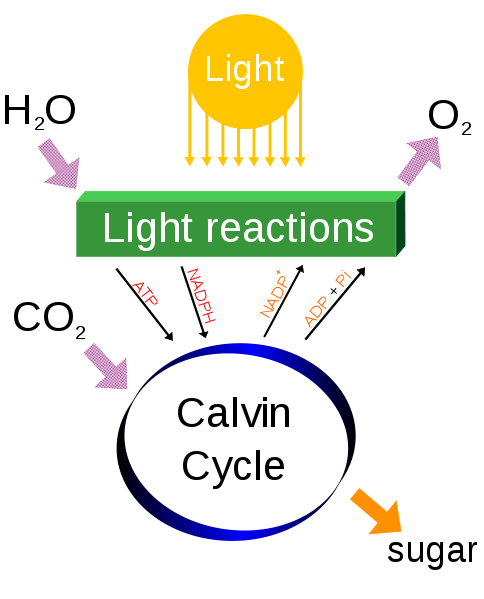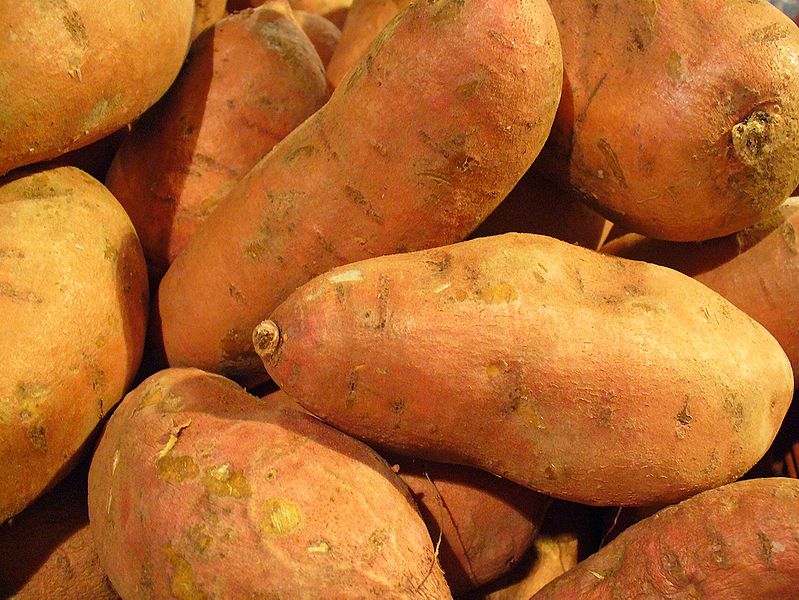
Nutrition of I. batatas
 All organisms need energy to survive. You and I
need to ingest food in order to acquire our energy, but how do
plants like the sweet potato get over this biological hump? Like all
other plants, I. batatas are photoautotrophs that generate
their own food through the process of photosynthesis. During
photosynthesis, light reactions occur within the leaves that lead to the
formation of a chemical energy stored in the form of sugar called
glucose. For this to occur, energy from sun light is harnessed by chlorophyl contained in chloroplasts, very crucial organelles found
in plant cells. Although photosynthesis is more efficient in the
leaves because of surface area, this process occurs in all green
parts of the sweet potato plant. Photosynthesis can be summarized by
this simple equation:
All organisms need energy to survive. You and I
need to ingest food in order to acquire our energy, but how do
plants like the sweet potato get over this biological hump? Like all
other plants, I. batatas are photoautotrophs that generate
their own food through the process of photosynthesis. During
photosynthesis, light reactions occur within the leaves that lead to the
formation of a chemical energy stored in the form of sugar called
glucose. For this to occur, energy from sun light is harnessed by chlorophyl contained in chloroplasts, very crucial organelles found
in plant cells. Although photosynthesis is more efficient in the
leaves because of surface area, this process occurs in all green
parts of the sweet potato plant. Photosynthesis can be summarized by
this simple equation:
6CO2 + 12H2O (+ light energy)-->C6H12O6 + 6O2 + 6H2O
Six molecules of carbon-dioxide, twelve molecules of water are beeing consumed in the process while one molecule of glucose, six molecules of oxygen, and six molecules of water are being produced. The water that is consumed in the process originates in the ground and is absorbed into the roots of the plant. Once in the roots, it can be distributed all throughout the plant via vascular tissue.
Photosynthesis occurs in two processes called the light reactions and the calvin cycle. In the light reaction, electrons go through two photosystems via solar energy, ultimately resulting in the production of NADPH and ATP. Oxygen is a byproduct of this reaction. NADPH and ATP are used to fuel the calvin cycle which converts CO2 to HCO2, a building block of glucose. NADP+ and ADP are recycled back into the photosystems to be used in the light reactions again. Another example organism that has developed this process of photosynthesis to acquire its nutrients is Serenoa repens, or more commonly known as Saw Palmetto. To learn more about photosynthesis and plant vascular tissue, click here!
Sweet Potato Nutrition Facts:
 Now that you know how this plant
receives its
nutrition, keep reading to find out how the sweet potato can
aide in your own nutrition!!
Now that you know how this plant
receives its
nutrition, keep reading to find out how the sweet potato can
aide in your own nutrition!!
Why the root of sweet potatoes is so popular for livestock and as a staple food can be answered simply by looking at it’s nutritional value. This super food is fat-free and contains 65 percent of the daily value of vitamin C in a one-cup serving. Vitamin C is important because it prevents the production of cancer causing compounds from nitrites and nitrates found in certain foods. Other vitamins found in sweet potatoes include B6, riboflavin, thiamin and niacin. A single one-cup serving provides 26 percent of ones daily fiber. Many minerals are taken into the sweet potato roots from the soil they reside in to keep the plant healthy. Minerals found in sweet potatoes include iron, calcium, phosphorous, potassium, sodium, zinc, copper, selenium, and a lot of manganese. In fact, one serving of sweet potatoes delivers more than half the daily requirement of manganese. Sweet potatoes are high in carbohydrates and can produce more edible energy that wheat, cassava, or rice. Most people believe carrots are the best food to eat if they are trying to include more beta-carotene in their diet. In fact, the sweet potato has more beta-carotene in a one-cup serving than any other member of the carotene family. Beta-carotene could be an important nutrient to have because scientists believe it may help prevent lung cancer and heart disease, help boost the immune system, and help reduce cataracts
Being a photosynthetic organism, the sweet potato is at the bottom of the food chain as a primary producer. Check out what organisms use the sweet potato as their own means of nutrition by clicking here!